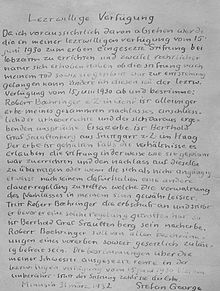Stefan George Foundation
The Stefan George Foundation is a literary foundation dedicated to the work of the German poet Stefan George (1868–1933). The foundation, which was founded in 1959 by Robert Boehringer and has since been recognized as a charitable foundation by the state of Baden-Württemberg, has its headquarters in Stuttgart and maintains the Stefan George archive in the Württemberg State Library .
history
Considerations for establishing a foundation go back to 1926. The idea came from Ernst Morwitz , a long-time friend and confidante of George, who was a councilor at the Prussian Supreme Court in Berlin. He drew the attention of George, who had been ailing again and again since 1915, to the possibility of transferring his copyrights to a foundation: “The foundation is necessary to separate the copyrights from your person, so that in the event of death they become independent and do not pass to the heirs . "A contract (probably mainly worked out by Morwitz) with the Georg Bondi Verlag from 1927, in which the rights to the first complete edition (1927–1934) were specified, already contained an" Article 9: Foundation " , which enabled the transfer of the copyrights to a foundation or a literary administrator (as such, Morwitz was “probably” envisaged). A will of George from June 15, 1930 instead of Morwitz provides Robert Boehringer (also a long-time friend and confidante of Georges) and the younger friends Johann Anton and Max Kommerell as the advice of a foundation "Das Werk Stefan Georges", which was supposed to be established in Switzerland . However, this plan failed due to Kommerell's rejection, who thus broke away from the George circle , and Anton's suicide a little later.
As a result, George wrote a new will on March 31, 1932, in which Robert Boehringer was appointed sole heir of the literary estate and copyrights. As a replacement and heir was Berthold Schenk Graf von Stauffenberg used. Regarding the planned foundation, the will said: “The inheritance is retained if the circumstances allow the foundation to be established in the way it was planned and the estate to be transferred to the same or if it turns out to be unsuitable for someone else To make permanent arrangements that guarantee the administration of the estate in my sense. ”When George died on December 4th, 1933 in Minusio , the establishment of a foundation was still not guaranteed. As early as January 1934, Berthold von Stauffenberg determined the further succession in consultation with Boehringer: the sculptor Frank Mehnert , who had been particularly close to George in the last years of his life, was appointed the second substitute heir, followed by Albrecht von Blumenthal and Claus Schenk Graf von Stauffenberg , Berthold's brother. The heirs set about securing the estate; they bought half of George's parents' house in Bingen am Rhein , which was bombed in World War II. However, the heirs had already brought the handwritten estate stored there to Boehringer in Switzerland, and George's library also survived the war in various places.
Boehringer began building an archive in his private home in Geneva , seeking contact with friends and acquaintances of George or their heirs. As early as the 1930s, he was able to collect important parts of the estate from the legacies of Friedrich Wolters , Ida Coblenz and Hugo von Hofmannsthal . Boehringer, who stayed in Switzerland, was the only heir spared the war and the National Socialist tyranny: Berthold and Claus von Stauffenberg were executed after their assassination attempt on July 20, 1944 , Frank Mehnert fell in the east, Albrecht von Blumenthal took his own life. Many of George's former friends had fled into exile to America or Australia from political and racist persecution, others had become entangled in the National Socialist system and mistrusted the liberal Boehringer. Nevertheless, he made contact with the survivors and began to build up a collection of manuscripts and valuable first editions. In 1946 he met Wilhelm Hoffmann , the director of the Württemberg State Library, who supported him in setting up the foundation and, at the same time, amalgamated a research library on George and his circle in his State Library.
With the support of Hoffmann and Boehringer's lawyer Maria Plum, the foundation was finally established in 1959 as a non-profit foundation under civil law: on July 30 of that year, the Ministry of Culture of the State of Baden-Württemberg approved the deed of foundation, and on August 10, 1959, Robert Boehringer signed it. The initial capital was 208,000 DM , of which 8,000 DM was non-touchable share capital. The first board of trustees consisted of Boehringer, Hoffmann and Plum. Boehringer soon transferred the copyrights as provided for in George's will to the foundation, which administered them until they expired on January 1, 2004. The holdings in Boehringer's private collection were gradually transferred to the Württemberg State Library. In 1974, after the death of Boehringer, the classical philologist Georg Peter Landmann (son of Edith and Julius Landmann ) took over the management of the foundation. Members of the Board of Trustees were also the edition philologist Elisabeth Höpker-Herberg , who took part in the conception of the Complete Works , the director of the Marbach literature archive Bernhard Zeller and Christoph Perels , the director of the Free German Hochstift (since 1990). After Zell's death in 2008, today's director of the Marbach Literature Archive and George researcher Ulrich Raulff was accepted into the board of trustees. From 1990 to 2001, Hans-Peter Geh was the third chairman of the foundation, succeeding Landmann.
Wolfgang Graf Vitzthum has been Chairman of the Board of Trustees since 2010 , which also includes the historian Carola Groppe , the literary scholar Ernst Osterkamp , Ulrich Raulff, Christoph Perels, Christoph Schücking and Hannsjörg Kowark .
tasks
According to the statutes, the foundation “promotes science and research, art and culture by serving the effect of his work in the spirit of Stefan George. For this purpose it maintains the Stefan George Archive ":" The archive is the place of work for editions of the works of Stefan George and for the bibliographical recording of all publications on George and his circle. In addition to the editorial work, it is responsible for organizing, securing and indexing and development and expansion of the existing holdings. It conducts its own research and promotes external research. " In addition to George's own estate, the Stefan George Archive's holdings include around 50 other estates, partial estates and collections from people from the so-called George Circle. Manuscript and library holdings are available for research in the George Archive after registration. The critical edition of Georges Complete Works , created in the archive, was completed in 2013. The Stefan-George-Bibliographie-online , based on preliminary work by George Peter Landmann, is developed in the archive and published online , which lists all of the printed works on Stefan George and the George circle that it knows about and is also the inventory of the reference library of the Stefan George Archive.
literature
- Fifty years of the Stefan George Foundation . Edited by Christoph Perels for the Stefan George Foundation in conjunction with Ute Oelmann and Wolfgang Graf Vitzthum. Walter de Gruyter, Berlin / New York 2009, ISBN 978-3-11-022084-1 .
Web links
- Stefan George Foundation on the website of the Württemberg State Library in Stuttgart
Remarks
- ↑ Ernst Morwitz to Stefan George, November 1, 1926, Stefan George Archive, quoted here from Christoph Perels: The Stefan George Foundation: History and Present . In: Christoph Perels (Ed.): Fifty Years of the Stefan George Foundation . Berlin / New York 2009, pp. 1–9, here p. 1.
- ↑ Contract between Stefan George and the Georg Bondi publishing house for the complete edition of the works of October 6, 1927 with Appendices I, II and III, printed in: Christoph Perels (Ed.): Fifty Years of the Stefan George Foundation . Berlin / New York 2009, pp. 74–80, here p. 79 (Article 9) and p. 80 (Morwitz as a possible administrator of the estate).
- ↑ To this Christoph Perels: The Stefan George Foundation: Past and present . In: Christoph Perels (Ed.): Fifty Years of the Stefan George Foundation . Berlin / New York 2009, pp. 1–9, here p. 2 f.
- ^ Last will of Stefan Georges of March 31, 1932, Stefan George Archive, printed in: Christoph Perels (Ed.): Fifty Years of the Stefan George Foundation . Berlin / New York 2009, p. 72.
- ↑ To this Christoph Perels: The Stefan George Foundation: Past and present . In: Christoph Perels (Ed.): Fifty Years of the Stefan George Foundation . Berlin / New York 2009, pp. 1–9, here pp. 3–5.
- ↑ To this Christoph Perels: The Stefan George Foundation: Past and present . In: Christoph Perels (Ed.): Fifty Years of the Stefan George Foundation . Berlin / New York 2009, pp. 1–9, here p. 5 f.
- ^ Christoph Perels: The Stefan George Foundation: Past and Present . In: Christoph Perels (Ed.): Fifty Years of the Stefan George Foundation . Berlin / New York 2009, pp. 1–9, here pp. 6–8.
- ^ Statutes of the Stefan George Foundation, approved by the Stuttgart Regional Council on November 5, 2001, in: Christoph Perels (Ed.): Fifty Years of the Stefan George Foundation . Berlin / New York 2009, pp. 59–61, here p. 59.
- ^ Statutes of the Stefan George Foundation, approved by the Stuttgart Regional Council on November 5, 2001, in: Christoph Perels (Ed.): Fifty Years of the Stefan George Foundation . Berlin / New York 2009, pp. 59–61, here p. 61.
- ^ Stefan George bibliography online .

